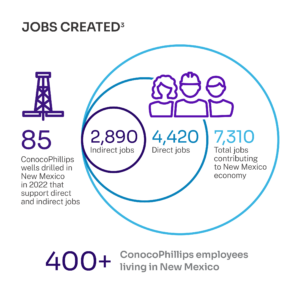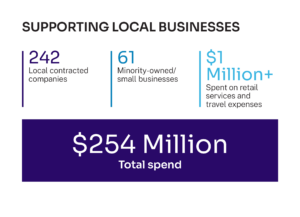ConocoPhillips contributes around $1 billion1 to New Mexico’s economy annually, including over $985 million in taxes and royalties that support essential services such as schools, emergency response, health clinics and roads.
As one of the largest producers in the state, we invest in the responsible development of the energy supply essential to human and economic progress. And this is nothing new – ConocoPhillips and its heritage companies have operated in New Mexico for almost 100 years.

We support more than 7,000 direct and indirect jobs.

Local businesses across the state benefit from ConocoPhillips operations. These businesses provide us with oilfield services and equipment, welding, excavation, construction, trucking, painting, inspections, building services and more.

We live and work here. We give our time, money and energy to support neighbors and communities.

We capture 99% of our gas in New Mexico.
ConocoPhillips has a proud history of operating our New Mexico oil and gas properties in compliance with applicable New Mexico Environment Department and Oil Conservation Division rules and regulations. Under such rules, we capture 99% of our gas in New Mexico.
In 2022, less than 1% of the water used for fracking in our Permian Basin operations was potable water.
We make use of produced water – water that returns to the surface during production – that is then treated and stored. The treated water remains in double-lined, engineered storage pits until needed for use in hydraulic fracturing, or fracking, new wells. As a result, we are reducing both the amount of water withdrawn from local sources and the amount of produced water injected for disposal. This process minimizes water-related risks while offering environmental and economic benefits.
Reducing methane emissions, even the small ones, is a key priority.
Company-wide, ConocoPhillips has reduced the intensity of our methane emissions by ~50% since 2015.
Our methane emissions reduction strategy includes detecting fugitive events early, evaluating and executing emissions reduction opportunities, validating emissions measurement through OGMP 2.0 and maintaining sound operating practices, including aerial and ground-based surveys for leak detection.
Read more about how ConocoPhillips is working to reduce methane emissions.
We participate in proactive conservation agreements to conserve specific species before they need to be protected through government regulations.
Our goal is to minimize impact and support proactive habitat and species conservation. We assess ecologically sensitive areas on company-owned land and integrate our understanding of these areas into the design of our development plans.
Other efforts include:
- Enhancing habitat connectivity and promoting biodiversity by using results from habitat assessments.
- Controlling invasive species.
- Reclaiming/restoring decommissioned frack pits, well and battery pads, roads, surface lines and electrical infrastructure, including evaluation of effectiveness of treatments in restoring impacted areas.
- Participating in programs recognizing landowners for efforts to provide high-quality habitat for pronghorn, mule deer and white-tailed deer.
Read more about how ConocoPhillips is working to reduce nature-related risks and impacts related to our operations or our proactive conservation efforts.
The world will continue to need oil for decades to come.
Credible net-zero projections show significant demand for oil for decades to come. The International Energy Agency’s “Net Zero by 2050” pathway shows global oil demand at 24 million barrels per day in 2050 – considerably less than today but also approximately twice what is currently produced by the U.S. During the transition, energy should come from the best possible projects and sources.
Products made from oil and gas are part of everyday life in New Mexico.
Oil and gas products are an integral part of life in the Land of Enchantment. More than 6,000 manufactured products we rely on are derived from oil and natural gas, from the cameras and film used in the state’s growing film industry to the tires on our mountain bikes to the cell phones in our pockets. Next time you enjoy a plate of green chili chicken enchiladas, take a moment to appreciate all the ways the natural gas and oil industry contributed to the meal. This includes electricity for automated irrigation, fuel for farm machinery and food processing, packaging, transportation and distribution.